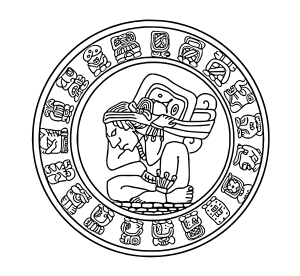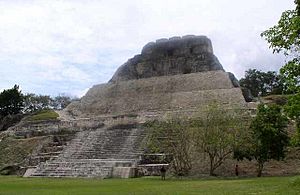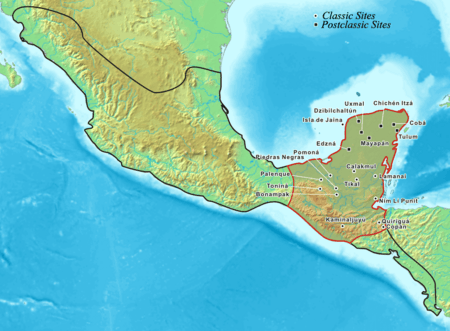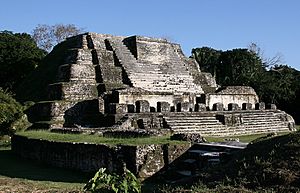Pre-Columbian Belize facts for kids
| 20000 BC – 1500 AD | |
 |
|
| Preceded by | Prehistoric Era |
|---|---|
| Including |
|
| Followed by | Columbian Era |

The Pre-Columbian Belize history tells us about the time before Europeans arrived. This period started when the first people came to the area that is now Belize. It covers thousands of years, right up to when Christopher Columbus and other Europeans first made contact. This era is often called "Pre-Columbian," meaning "before Columbus."
Belize's story begins with the Palaeoindians. These were people who moved around a lot, like nomads. They traveled from Asia to the Americas. This journey might have happened as early as 35,000 years ago. They crossed a frozen land bridge called the Bering Strait. Over many thousands of years, their descendants settled across the Americas. They created many different cultures in North, Central, and South America. The amazing Maya culture grew in the lowlands of the Yucatán Peninsula. This area includes parts of modern-day Mexico, Guatemala, Honduras, and Belize. The main parts of Maya civilization developed between about 2500 BC and AD 250. The Maya civilization reached its peak during the Classic Period, which began around AD 250.
Even after nearly 500 years of European presence, many parts of the Maya culture still exist today. Everything we know, from old artifacts to historical records, shows that the culture in this region has continued. The descendants of the first people who settled here have lived in this area for at least 3,000 years.
Contents
Archaic Period (c. 8,000—2,500 BC)
During the late Archaic period, around 3000 BC, some groups of hunters and gatherers started to settle down. They formed small farming villages along the coast of what is now Belize. Hunting and gathering were still important for food. But these farmers also grew crops. They domesticated plants like maize (corn), beans, squash, and chili peppers. These foods are still basic parts of meals in Central America today.
These early farmers used different ways to grow their food. Some used irrigation systems, which brought water to their fields. Others used ridged-field systems. They also practiced "slash-and-burn" agriculture. This involves cutting down and burning plants to clear land for farming. Their crops fed many people in their civilization. This included craftspeople, merchants, warriors, and priest-astronomers. These priests watched the sun, moon, planets, and stars. They used this knowledge to create a complex system for math and calendars. This helped them plan farming and other activities. They also recorded important events on carved stone monuments called stelae.
Maya Civilization
Preclassic Period (c. 2500 BC—250 AD)
During the Preclassic period, the settlements along the coast grew bigger. They also spread west into the inland areas.
New discoveries from western Belize show that people using pottery lived there very early. This was around 1200 BC at places like Cahal Pech and Blackman Eddy. These are some of the earliest known pottery technologies in western Belize. At sites further north, pottery is thought to have appeared a bit later.
At the Cuello site, pottery jars, bowls, and dishes have been found. Some of these date back to 1000 BC. They are among the oldest pottery found in all of Mesoamerica. The Cuello site is about five kilometers west of Orange Walk Town. It has platforms of buildings arranged around a small plaza. This shows it was a distinct Maya community. Finding shells, hematite, and jade at the site tells us something important. It means the Maya were trading over long distances as early as 1500 BC. However, the Maya economy was still mostly about getting enough food to survive. They combined foraging, farming, hunting, and fishing.
Cerros, a site on Chetumal Bay, was a busy trading and religious center. It thrived between about 300 BC and AD 100. Cerros shows some key features of early Maya civilization. Maya architecture included temples and large homes for important people. These buildings were grouped around open plazas. They were built from cut stone, covered with stucco, and beautifully decorated.
The Maya created a highly developed style of art. They made detailed carvings and paintings of people, animals, and gods. They also created sculptured stelae and geometric patterns on buildings. At Cerros, impressive six-foot-high masks decorate the temple platform. These masks are on either side of the main stairway. They represent a serpent god.
Classic Period (c. 250—900 AD)
Altun Ha
The Maya were very skilled at making pottery. They also carved jade, shaped flint into tools, and made amazing costumes from feathers. One of the largest carved jade objects ever found was discovered at Altun Ha. This site is about thirty kilometers northwest of modern Belize City. It was found in a tomb from the Classic period. This jade object is often said to be the head of the sun god, Kinich Ahau. However, it looks quite different from this god, except for its square, squinting eyes. People settled in the Altun Ha area as early as 200 BC. At its peak, Altun Ha had an estimated 8,000 to 10,000 residents.
At the start of the second century AD, the people of Altun Ha built their first major temple. Today, visitors can see a group of temples, homes for priests, and other buildings. These are arranged around two connected plazas. Nearby, there are hundreds of other structures. Most of these have not yet been dug up by archaeologists. The Maya continued to rebuild some of their temples until almost the end of the ninth century.
Archaeological digs at Altun Ha suggest a possible reason for the civilization's decline. Evidence points to a revolt, perhaps by farmers against the ruling priests. This may have helped lead to the downfall of the civilization. People might have continued to live at or visit the site in the Postclassic period. But the main ceremonial centers were left to decay. Some trash found at Altun Ha shows people were there in the thirteenth and fourteenth centuries. They might have been reusing old buildings or visiting the old religious center.
The history of the central and southern parts of Belize is largely about Caracol. The writings on their monuments, like elsewhere, were in Classic Ch'olti'an, a Maya language. North of the Maya Mountains, the language used for writings at Lamanai was Yucatecan by 625 CE. Other important Maya centers in Belize include Xunantunich and Baking Pot in Cayo District. Also, Lubaantún and Nimli Punit are in Toledo District.
Xunantunich

Xunantunich means "Lady of the Rock." People might have lived there as early as 300 BC. But most of the buildings you see today were built in the late Classic period. Like all Maya centers in the lowlands, people kept building new temples and homes over older ones. They made the platforms and structures bigger and taller each time. The views from Xunantunich's "El Castillo" are amazing! At 128 feet tall, it is one of the tallest human-made structures in Belize. Canaa (Sky Palace), located at Caracol, is even taller at 140 feet. It is Belize's highest human-made structure.
Lamanai is harder for tourists to reach than Altun Ha or Xunantunich. But it is a very important site. It shows archaeological proof of Maya presence over many centuries, starting around AD 150. Many people lived there throughout the Classic and Postclassic periods. In fact, people living in the Lamanai area were still fixing up some of the huge ceremonial buildings. This was happening even after big centers like Tikal in Guatemala were mostly abandoned in the tenth century.
Late Classic Period
In the late Classic period, it's thought that between 400,000 and 1,000,000 people lived in the area that is now Belize. People settled almost every part of the country that was good for farming. They also lived on the small islands (cayes) and in coastal swamp regions.
Postclassic Period (c. 10th—early 16th century)
In the tenth century, Maya society faced a big collapse. Building of public structures stopped. The main administrative centers lost their power. The population also went down. This happened as the social and economic systems became disorganized. Some people continued to live at, or perhaps returned to, sites like Altun Ha, Xunantunich, and Lamanai. But these places were no longer grand ceremonial and civic centers.
At the end of the Postclassic period, the area that is now Belize had three different Maya territories. These were Chetumal Province, which was around Corozal Bay. Then there was Dzuluinicob Province, which stretched between the New River and the Sibun River, west to Tipu. Finally, there was a southern territory controlled by the Manche Ch'ol Maya. This area was between the Monkey River and the Sarstoon River.
Readings



